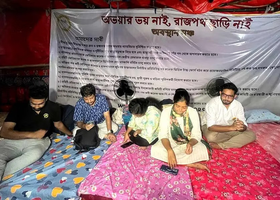Junagadh, Oct 10 (VOICE) As local villagers oppose the proposed eco-sensitive zone (ESZ) around the Gir Protected Area, home to the Asiatic lion, the Gujarat Forest Department has launched an outreach initiative to address concerns and clear misconceptions.
The department has begun distributing leaflets across 196 villages that would be part of the ESZ to dispel fears about restrictions on villagers’ rights and activities.
The proposed ESZ, covering 2,061.77 square kilometres around the Gir Protected Area, has drawn protests from residents who fear their livelihoods will be affected. They worry that their land rights could be curtailed and that the Forest Department would impose tight control over activities in the zone.
Several rallies have been held, and memorandums have been submitted demanding the notification’s cancellation.
However, forest officials are now working to calm these fears, claiming that certain vested interests are misleading the farmers to incite them against the ESZ for personal gain.
Rajdeep Jhala, Deputy Conservator of Forests, Gir East, said that the department is distributing 20,000 to 22,000 leaflets in public places such as markets, religious sites, and taluka areas like Dhari, Khambha, Una, and Gir Gadhada.
“Some people are using farmers for their benefit. But the ESZ will not affect farmers’ livelihoods,” Jhala said.
Officials clarified that while the ESZ would restrict activities like commercial mining, stone quarrying, and large-scale industrial operations, there would be no restrictions on mining for personal use.
They added that other activities, like running hotels and resorts, would be regulated, but standard agricultural practices, tree cutting, and vehicle movement would remain unchanged.
They also emphasised the Forest Department’s commitment to promoting sustainable initiatives like rainwater harvesting, organic farming, green technology, and agroforestry within the ESZ.
Through the leaflets, the department assured farmers that their agricultural practices would not face new restrictions and that the government would allocate a special budget for the area’s development. Field staff have been instructed to hold small meetings with villagers to address any concerns further, aiming to engage directly with communities.
The ESZ around the Gir Protected Area now extends between 2.78 km and 9.50 km, reducing the total area from the 2016 gazetted notification. The zone covers 1.84 lakh hectares, including over 24,000 hectares of forest land and 1.59 lakh hectares of non-forest land. It stretches across 196 villages, including 17 rivers in the Junagadh, Amreli, and Gir-Somnath districts.
The Gujarat government’s move to declare the ESZ aims to provide additional protection to the Asiatic lion and the surrounding ecosystem.
Forest and Environment Minister Mulu Bera said that the ESZ would safeguard critical lion and river corridors, essential for the movement and conservation of the lion population.
Bera also pointed out that the buffer zone would promote sustainable development in these areas.
“The ESZ will not only protect the lions but also create a balance between environmental conservation and developmental activities,” he said.
He added that both state and Central governments have been employing advanced technology and innovative projects to ensure the continued survival of the Asiatic lion, the only such population in Asia.
Bera urged the public to avoid using unauthorised websites and to book safaris through the official government portal – girlion.gujarat.gov.in – to ensure that visitors are not overcharged or misled.
He added that the Forest Department has been monitoring the situation closely to ensure that tourism in the Gir region remains regulated and fair.
–VOICE
janvi/dan













Leave a Reply